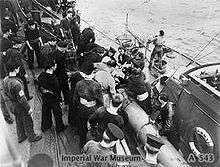Texel Disaster
The Texel Disaster took place off the Dutch coast on the night of 31 August 1940 and involved the sinking of two Royal Navy destroyers, and damage to a third and a light cruiser. The disaster was caused by a destroyer flotilla running into an unmarked minefield, which caused serious damage to one vessel; two more destroyers were sunk going to the aid of the first, and a light cruiser sent as an escort was slightly damaged by a mine on the return journey. In all, the disaster caused approximately 300 deaths, with a further 100 men injured or taken prisoner of war.
The disaster
On the night of 31 August 1940, the British 20th Destroyer Flotilla – consisting of HMS Express, Esk, Icarus, Intrepid and Ivanhoe – sailed from Immingham to the Dutch coast northwest of Texel to lay mines.[1] The flotilla was joined by part of the 5th Destroyer Flotilla consisting of HMS Kelvin, Jupiter and Vortigern.[1] While the ships were laying mines, air reconnaissance detected a German naval force moving west from Terschelling towards Britain; fearing an invasion the 20th flotilla was ordered to intercept.[2]

Whilst heading for this German force, the flotilla ran into a newly laid, uncharted minefield and Express was badly damaged, losing most of her bow.[3][4] The explosion caused heavy casualties: ninety of the 175 men on board were killed or wounded, including her captain, J.G. Bickford, who was injured by the explosion.[4] The flotilla commander, Lieutenant-Commander Crouch, moved his ship, Esk, to assist Express but Esk also hit a mine and the vessel swiftly sank, killing all on board, save one man.[4] Ivanhoe then went to transfer the wounded from Express but also hit a mine and was badly damaged, the explosion killing a further 53 men and wounding the majority of the crew.[4] Several life rafts, carrying shipwrecked sailors, drifted into the Dutch coast where those on board were detained by the German authorities as prisoners of war.[4]
1 September brought Kelvin and Jupiter from the 5th flotilla to help rescue the shipwrecked crews and later two light cruisers – HMS Aurora and Galatea – arrived as an escort.[1][5] Ivanhoe was scuttled by fire from Kelvin and the ships returned to port.[1] Jupiter towed the hulk of Express until tugs could be sent out to take over.[6] On the way, Galatea hit a further mine and was slightly damaged.[1]
Aftermath
The final toll of the disaster was approximately 300 killed, with a further 100 injured or taken prisoner; this was the greatest loss of life suffered by Nore Command since the evacuation of Dunkirk.[4] The German "invasion force" turned out to be a small minelaying unit transferring from Cuxhaven to Rotterdam.[4] The casualties returning from the disaster, some badly burned, contributed to the myth that a German invasion had been repulsed by the use of burning oil floated on the sea.[7] One theory amongst British civilians and press of the time laid the blame for the disaster with Lord Louis Mountbatten.[3]
Notes
- 1 2 3 4 5 U-Boat reference site entry on Ivanhoe
- ↑ Hayward 2001, pp. 33–34.
- 1 2 Haining 2004, p. 178.
- 1 2 3 4 5 6 7 Hayward 2001, p. 34.
- ↑ Naval History entry for Kelvin
- ↑ Naval history entry on Jupiter
- ↑ Hayward 2001, p. 33.
References
- Hayward, James (2001), The bodies on the beach:Sealion, Shingle Street and the burning sea myth of 1940, Dereham, Norfolk: CD41, ISBN 0-9540549-0-3
- Haining, Peter (2004), Where the eagle landed:The mystery of the German invasion of Britain, 1940, Robson, ISBN 1-86105-750-4